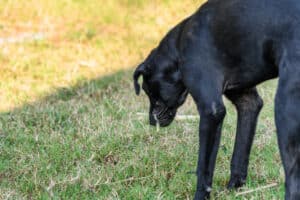Life has existed on Earth for approximately four billion years. A lot of this life was freaking terrifying. Were it not for evolution; we would all be experiencing bad dreams. But why?
The animal kingdom is dominated by strange and formidable creatures that, even with technology, we cannot afford to keep them. Clearly, many of these diminutive species are a reflection of giant descendants that would terrify the entire world. Moreover, these mind-boggling animals used to have super-huge relatives.
We are all fascinated with dinosaur times. But did you know that even after the massive extinction wiped out dinosaurs, many interesting creatures still roamed the planet before human dominance?
Many different megafauna species roamed the Earth, some of which have close relations to modern-day animals.
Today, we discover eight incredible animals that used to be great.
The Huge Ape (Gigantopithecus blackii)

The mysterious ape weighed about 600 pounds and stood up to 10 feet.
©Concavenator / CC BY-SA 4.0, , via Wikimedia Commons – License
Gigantopithecus blackii was the biggest ape that ever walked on planet Earth. However, research indicates it could have died due to a limited diet and its vast size. Fortunately, its diet consisted of bamboo. But when forest habitats shrank a century ago, the giant animal might not have been sustained by food for reproduction and survival.
The mysterious ape weighed about 600 pounds and stood up to 10 feet. But scientists are yet to explore this distant relative to orangutans fully. The first hint was around 1935 after a German paleontologist found the ape’s molars being sold in a pharmacy. The label “dragon teeth” caught his attention, and he researched more about it. Chinese traditional practitioners believed that the teeth were divine healers of various disorders.
Since then, scientists have found a few partial jaws and dozens of teeth belonging to the huge ape. Based on fossils, blackii could have gone extinct about 100,000 years ago. However, more research indicates that its close relatives are African primates like chimpanzees.
It is likely that every time the climate got drier and cooler, the forested region shrank, crashing the population of this giant primate. Today, chimps have smaller bodies, and their metabolism reduces during unstable seasons to keep their population thriving.
The Spike-Toothed Salmon (Oncorhynchus rastrosus)
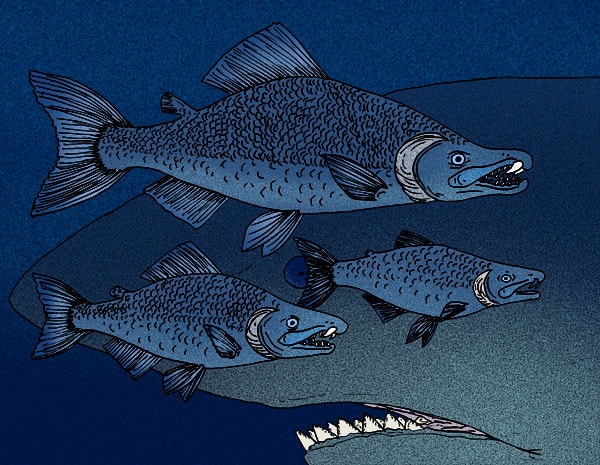
Using the fossil remains, researchers could tell how the behemoth bred and lived. Scientists called it saber tooth salmon due to its solid and long teeth on the upper jaw.
©600 × 465 pixels, file size: 174 KB, MIME type: image/jpeg – License
At eight feet and 400 pounds, the spike-toothed salmon would be an enormous meal. Oncorhynchus rastrosus lived in California for nearly seven million years and disappeared around five million years ago. The monstrous salmon had fighting teeth stuck out from the snout-like spikes. It was a member of the modern-day pacific salmon family, and it luckily left hints about its life.
Using the fossil remains, researchers could tell how the behemoth bred and lived. Scientists called it sabertooth salmon due to its solid and long teeth on the upper jaw. However, the teeth pointed outward as opposed to facing downward. The giant teeth measured approximately 1.5 inches long, likely used for fighting, breeding, and digging.
The modern-day pacific salmon fight during the mating season, but did the spike-toothed salmon do the same? Typically, living male salmons get their bodies and spawn for the battle. As a result, they form a kype (an upward hook on the lower jaw) as they prepare for the mating season. It is, therefore, possible that the giant salmon used the spike teeth for the same purpose.
Further studies have revealed that the huge salmon in saltwater environments were shorter and had signs of wear compared to their counterparts in freshwater. The spiky teeth could have also been a sign of dominance.
The Ancient Penguin (Palaeeudyptinae)
The largest modern penguin is estimated to be about three feet tall. This is small compared to the ancient penguin that weighed 220 pounds and stood six feet tall.
The bird’s fossil was the size of a refrigerator, and scientists thought it belonged to a huge turtle genus.
The ancient bird was so gigantic that researchers thought it developed after evolution when birds lost their flying abilities. The shoulder blade was the first hint that the fossil was a penguin, not a turtle. Further analysis discovered that the bird lived seven to 11 million years ago.
But the ancient penguin did not look much like today’s penguins. Instead, the extinct birds had longer beaks that could be used to spear fish. More fossils were recently discovered in New Zealand, estimated to have lived 61 million years ago.
New Zealand was a penguin paradise because it was a fish hub for penguins to feed on. More so, there were no native mammals, meaning it was a land free of predators. Instead, penguins lived freely on the shore to lay eggs and warm their feathers.
The Giant Dragonfly (Meganeura)
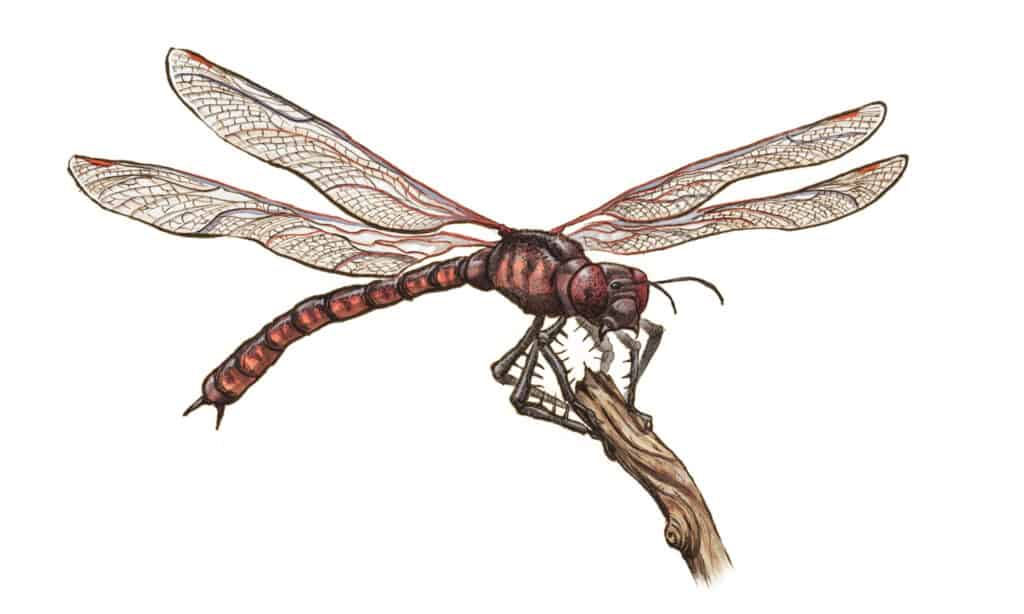
Meganeura had spiky solid legs for seizing prey.
©Filippo Vanzo/Shutterstock.com
The dragonflies found in the U.S. are the largest of all dragonfly species. Most people identify them by their abdomen and size. But no living specimen can be compared with the extinct insect, Meganeura, which lived about 270 million years ago. The insect ruled the skies before bats, and birds even evolved.
Meganeura is an extinct insect that was huge and predatory, like the modern damselflies and dragonflies. But insects breathe through spiracles and not lungs. This explains why living insects are tiny and can’t get as huge as their extinct relatives.
The giant dragonfly had a pair of powerful and toothed mandibles to tackle struggling prey, suggesting they were predaceous. Besides, they had spiny front limbs for a firm grip and powerful jaws for swift attacks.
The lack of predators is one of the explanations for why giant dragonflies existed. This allowed the insects to grow in maximum size during the Permian and carboniferous periods. It is also believed that their preying and hunting methods were similar to modern-day dragonflies. But they preyed on more organisms due to their gigantic size.
However, they could not survive the current atmospheric conditions, leading to extinction. With their breathing mechanism, these ancient insects allowed a huge amount of air into their internal tissues. With the current oxygen levels at 21% from 35% in the carboniferous period, it could be challenging for these insects to survive.
The Ground Sloth (Megatherium)
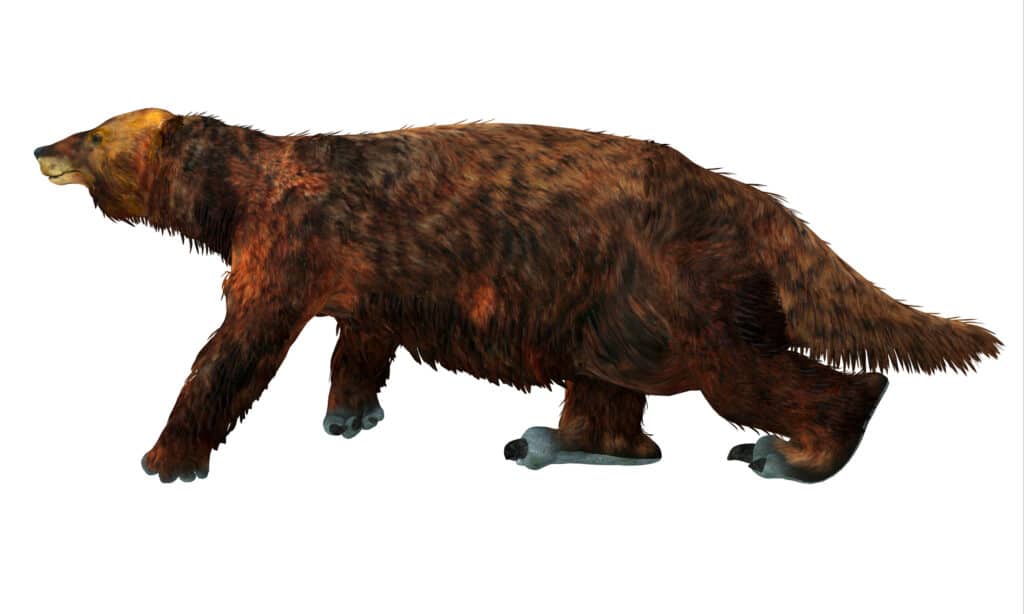
The ancient relatives of the
living sloths
lived true to their name. They could stand using hind legs, making them the most titanic bipedal animals alive.
©Catmando/Shutterstock.com
Nutritionists say that avocado is the best fat you can eat. However, if you are a fan of this nutritious fruit, you should thank the gigantic ground sloths. These huge animals were among the herbivores that could entirely swallow avocados. Hence, they dispersed seeds of this incredible fruit we all love.
Tropical ecosystems rely on animals to spread their seeds. Only giant herbivores like ancient sloths could carry avocado seeds in their digestive systems and defecate far from the parental tree.
The ancient relatives of the living sloths lived true to their name. They could stand using hind legs, making them the most titanic bipedal animals alive. The average size of the formidable sloths stood 12 feet tall and weighed about four tons.
South American sloths vanished into extinction approximately 10,000 years ago. Their North American counterparts had encountered the same fate 1,000 years earlier. The previous fossil study revealed that 200-pound ground sloths were alive about 4,200 years ago.
The giant sloth lived in forests along lakes or rivers during the Great Ice Age. During this period, 30% of the Earth’s surface was covered by glaciers. The environment then was harsh, and only a few animals could survive.
They fed on vegetation and had long curved claws to help them grab branches and prevent stripping from tree limbs. In addition, their postures and hind foot structures helped these animals during meal times.
The Short-Faced Bear (Arctodus)
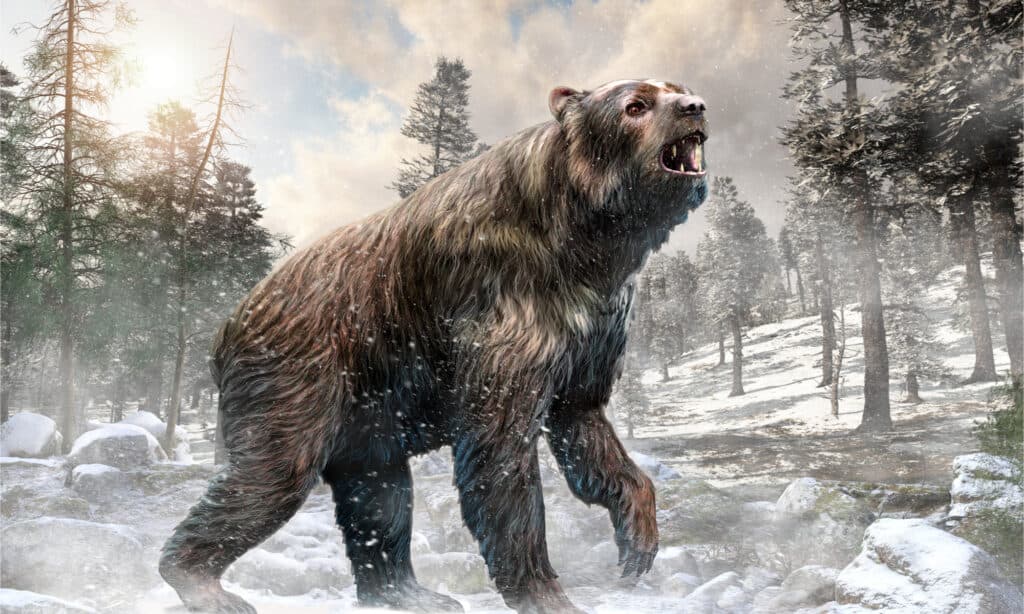
Arctodus was believed to weigh 2,000 pounds or more.
©Warpaint/Shutterstock.com
The short-faced bear was a fast and swift bear genus on Earth’s surface. The longer, powerful animal was about five feet wide and 12 feet tall while on its hind legs. Unlike modern bears, the ancient bear had their toes pointing forward to facilitate fast moves and gait.
The short-faced bear’s shearing teeth and skull indicate that it was highly carnivorous. The eye sockets were set wide apart, its face facing forward for incredible vision. It had large jaws and huge insertions to boost its biting muscles for crushing bones.
Giant short-faced bears (known scientifically as Arctodus simus) were mainly found around the Mississippi River, Alaska, and Minnesota. They likely preyed and scavenged on herbivores like ground sloths, deer, and horses. Their extinction is linked to the end of the Ice Age.
A close relative to the giant short-faced bear species was known scientifically as Arctodus priistinus. It inhabited Mexico and areas near the Atlantic coast. This smaller species had smaller teeth and a longer face. It is believed to have been omnivorous. This species may have gone extinct due to competition with its larger close cousins, the grizzly bear and the black bear, invading its territory at the end of the Ice Age.
The spectacled bear of South America is the only relative of the giant short-faced bears. Unlike its ancestors, it is smaller (the same size as a black bear) and considered omnivorous.
The Giant Sea Scorpion (Eurypterids)
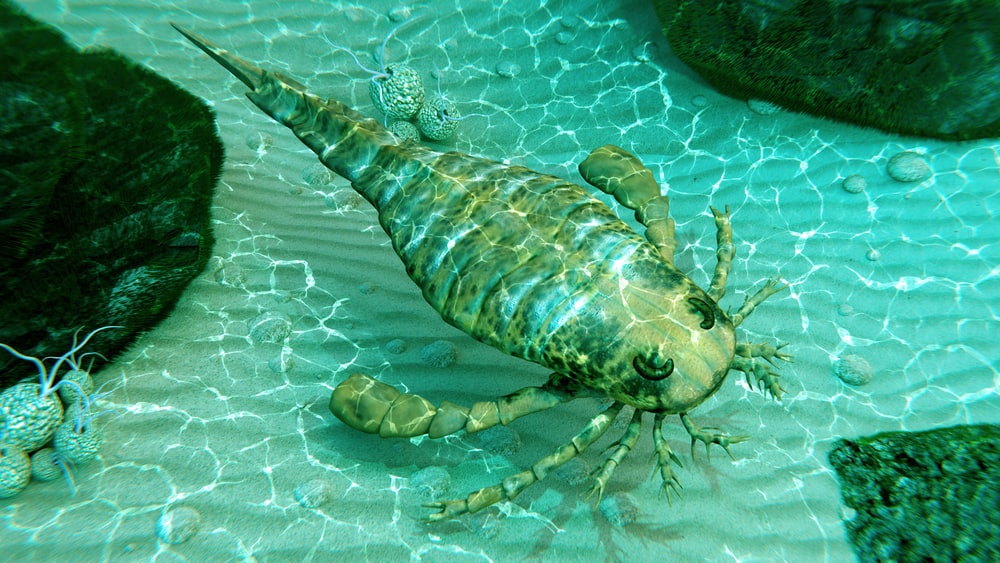
An illustration of eurypterus exploring sea floor. Eurypterids are related to arachnids and include the largest known arthropods to have ever lived (460 to 248 million years ago).
©Aunt Spray/Shutterstock.com
Various armored predators ruled seas and oceans, and the sea scorpion was among them. These creatures were as giant as a human hand, and others grew larger than humans. During the Paleozoic era, the oceans were filled with wild invertebrate herbivores and predators. These creatures lived for a long time and came in various terrifying forms.
The Giant sea scorpion thrived in the Silurian era. But, then, the creature was of its own kind and seemed to have been widespread by today’s standards. It lived in streams and freshwater lakes, unleashing its eight-foot anthropoid rage on prey. Although known as a sea scorpion, the arthropod was like an oversized lobster with claws that were the size of a man’s head.
Today, we depend on freshwater oceans as alternative swimming bodies because predators dominate rivers. The dozens of extinct sea scorpions crawling in the silt would affect activities in the ocean and around the shores. For example, the amount of food the beast would need would drastically reduce fishing trips.
The Giant Cheetah (Acinonyx pardinensis)
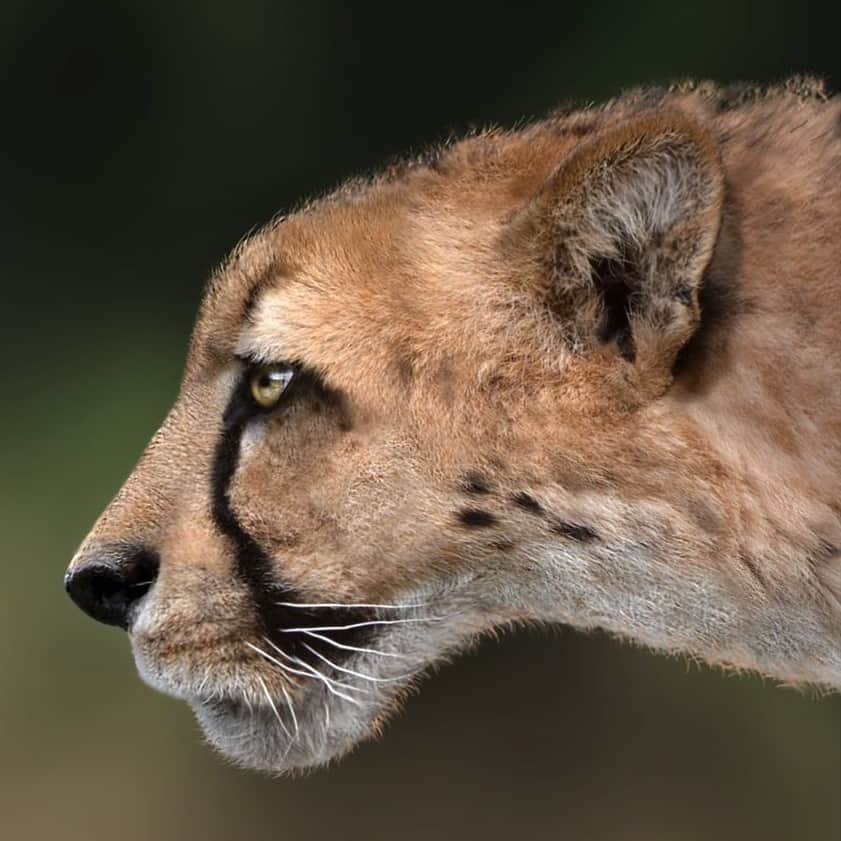
Based on its paw and arm bones, the huge
cheetah
weighed about 220 pounds, double the size of its modern relative.
©841 × 841 pixels, file size: 189 KB, MIME type: image/jpeg – License
Last on our list, but not least, is the Giant cheetah. The prehistoric cheetah, Acinonyx pardinensis, was highly predatory, just like the modern-day species. Its existence evidence was discovered on a site at Dmanisi.
Based on its paw and arm bones, the huge cheetah weighed about 220 pounds, double the size of its modern relative. Based on various findings, the extinct animal thrived as a killer, living on about 16,500 pounds of prey yearly. The bounty meat would provide plenty of leftovers to other animals and perhaps humans.
Whether the animal also hunted humans is not clear. But in the prehistoric era, just as now, the big cat family was considered hypercarnivores and fed on soft tissues.
This giant cheetah is believed to have been a messy eater that would leave plenty of flesh around the landscape. But without any teeth collection, it is difficult to tell the ecological role played by the Dmanisi cheetah.
Up Next…
- Discover 8 Of The Biggest Animals That Have Gone Extinct
- Gigantopithecus: The Giant Extinct Orangutan
- Giant Squid vs Blue Whale: Comparing Two Giants
The photo featured at the top of this post is © Daniel Eskridge/Shutterstock.com
Sources
- U Oregon, Available here: https://mnch.uoregon.edu/collections-galleries/spike-toothed-salmon
- Research Gate, Available here: https://www.researchgate.net/publication/228491381_Prehistoric_Sloth_Extinctions_in_Cuba_Implications_of_a_New_Last_Appearance_Date
- Berkeley, Available here: https://ucmp.berkeley.edu/paleozoic/paleozoic.php
FAQs (Frequently Asked Questions)
What do scientists know about the Huge Ape?
Scientists have found a few partial jaws and dozens of teeth belonging to the huge ape. Based on fossils, blackii could have gone extinct about 100,000 years ago. However, more research indicates that its close relatives are African primates like chimpanzees.
What is the short faced bear?
The short-faced bear was a fast and swift bear genus on Earth’s surface. The longer, powerful animal was about five feet wide and 12 feet tall while on its hind legs. Unlike modern bears, the ancient bear had their toes pointing forward to facilitate fast moves and gait.
Thank you for reading! Have some feedback for us? Contact the AZ Animals editorial team.




